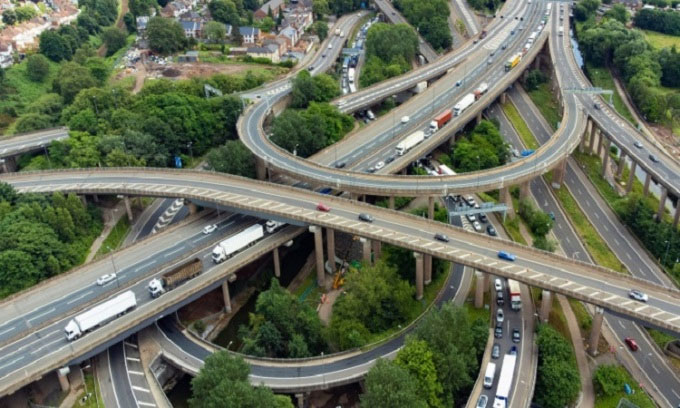The Gravelly Hill Interchange in Birmingham is one of the most complex traffic junctions on the planet, featuring 5 levels, 559 concrete columns, and a height of over 24 meters.

The “Pasta” interchange viewed from above. (Photo: ChrisHepburn/iStock)
Inaugurated on May 24, 1972, Gravelly Hill is famous for its unique shape resembling a plate of pasta. It was the first straight-through interchange in the UK without traffic lights or roundabouts. Gravelly Hill plays a crucial role in the Midland Links project, connecting the M1 (London – Yorkshire), M5 (Birmingham – South Wales), and M6 (Birmingham – Preston) motorways. These routes are the three main branches of the UK’s National Motorway Network.
In 1958, the Department of Transport appointed the firm Sir Owen Williams and Partners as consulting engineers to explore options for connecting the three routes. The engineering team decided that a straight road would connect better with key residential areas than a longer ring road, which would avoid densely populated regions. To minimize the number and cost of demolitions required to create a straight route, they opted to utilize existing routes that passed through canals, rivers, and road bridges. The project included 69 kilometers of suburban motorways, 37 kilometers of urban motorways, and 17 interchanges. The engineering team also constructed 21.3 kilometers of elevated road over the River Tame, creating the longest continuous elevated road in the UK, measuring 5.6 kilometers between Gravelly Hill and Castle Bromwich.
The construction of the interchange took 4 years, starting in 1968 and opening in 1972. The construction cost amounted to 12 million USD at that time. This interchange is incredibly complex, featuring multiple traffic lanes and comprising 5 levels. Engineers used a total of 13,000 tons of steel and 134,000 cubic meters of concrete. The interchange has 559 supporting concrete columns, with the tallest column reaching 24 meters.
Upon its opening, the average traffic flow through the Gravelly Hill interchange was 40,000 vehicles per day. This number increased to 140,000 vehicles by 2002 and over 210,000 vehicles by 2012. According to the National Highways Authority, the structure was designed to last for 120 years.


















































